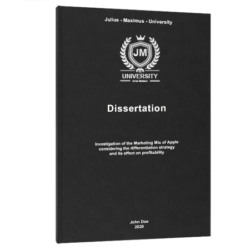
“Et al.” is a popular expression used by college and university students when citing a research source having more than one author. Included in this article is its definition, how to use it when using different citation styles, and the most frequently asked questions regarding the use of et al. The information contained here is vital, as it will assist you to know how to use the term correctly, which may, in the long run, help in boosting your grades.
Use of et al. - FAQ
Et al. is an abbreviation of et al. ii, a Latin expression, which means ‘and others’. You often need to make use of et al. in a citation that has three or more authors.
Its purpose is to assist in making the citations manageable. If you are using the author’s name, you have to ensure you add a full stop after writing et al.
Tip: If you are done with your academic work, we can help you with dissertation printing!
Some college students don’t know how to make the right use of et al. Whenever you have to use the term, you have to note that the “al” should always have a period after it.
The period is vital because et al. is an abbreviation. Including the period helps to show this to the reader.
Learning the use of et al. also means learning how to pronounce it. If reading it aloud, you will be required to pronounce the term in full, i.e., “et alia” or “et al. ii”.
On the other hand, you could also choose to say “and others.” It’s the same way you would opt to say “for example,” as opposed to reading the abbreviation “e.g.”
Not sure how to make use of et al. in an email? It’s possible to do so. For example, in the greeting section, you could say Dear Daniel et al.,
Hello, Kevin et al.,
Remember that the expression stands for “and others.”
When using et al., you shouldn’t underline or italicize it. You have to write it without either of the two.
As a rule, the most commonly used Latin abbreviations and words shouldn’t be italicized.
Use of et al.: Definition
Definition 1: et al. and others: It’s an abbreviation of ‘et alii’ which is used when the author is referring to a group of people.
Definition 2: et al. and elsewhere: Authors use it when they want to refer to other occurrences in the text.
Why it’s used: When citing papers that use the name and dating system, it can prove awkward when the author provides a long string containing numerous names. It’s the reason why many scientific journals recommend that authors make use of et al.
When it’s used: Its recommended to try to make use of et al. when an author doesn’t want to have to name all the things or people in a list. The abbreviation works in the same manner as “etc.”
Use of et al. in Citation
Using Et Al. in APA Citation
APA citation happens to have a few quirks, with one of them being in the use of et al. While the abbreviation is used when citing sources having many authors, the 7th APA citation edition happens to differ from the rest in terms of how to make use of et al.
Only make use of et al. when using in-text citations
The 7th edition states that et al. should only be used when one is using in-text citations. It’s a significant change from the previous edition where authors could use et al. in the reference list.
This means that the reference list in the 7th edition doesn’t support the use of et al.
In-text citation format using et al.
Et al. should only be used in in-text citations when an author wants to reference a source having three or more authors.
Here, you can make use of et al. by including the authors first name, and then including et al. in every other Citation.
Exceptions: Multiple works sharing a single author
There are instances when making use of et al. could lead to unwanted problems. For example, when numerous works share the same three authors and year of publication, simply writing “et al.” could muddy the waters.
When dealing with such a case, it’s recommended to write as many names as possible to help differentiate the references. You can then make use of et al. for any remaining names.
Using Et Al. in MLA Citation
For MLA citation, it’s recommended that you make use of et al. whenever there are sources with more than three sources.
It’s a rule that applies to both the Works Cited list and the in-text citations.
| Number of Authors | In-Text Citation Example | Works Cited Example |
| 1-2 Authors | Smith and Davies | Smith, Joshua, and Robert Davies |
| 3+ Authors | McDonell et al. | McDonnell, Frederick, et al. |
Using Et Al. in Chicago Citation
Chicago Style Citation traditionally has two citation systems: author-date style and notes and bibliography style. The use of et al. doesn’t differ in both styles.
When working with sources with one, two, or three plus authors, you will need to list all their names in your in-text citations (author-date or footnotes).
In case you have a source with four-plus authors, then it’s advisable to use et al. by listing the first name and following it up with et al.
In the Chicago style bibliography or reference list, you will need to list up to ten authors. For any source with over ten authors, you should list the first seven and then follow this with et al.
For example, Harold Peters, McDonnel, Anne Elliot, Frederick, Robert Davis, Molly Davidson, Ronald Clobus, Jessica Singh, et al.
Use of et al. Common Mistakes
I. Most students tend to make use of et al. with works that don’t have multiple sources. Remember, you only need to use it when the source has more than three authors.
II. Punctuation Mistakes: the “al” in “et al.” should always have a period after it. The reason for using the period is because “et al.” is an abbreviation. It’s why you need the period.
- Where necessary, it can also be followed by another punctuation mark where deemed necessary. However, make sure that the period comes first, before the other punctuation mark.
III. Et al. vs etc. Some students end up confusing “etc.” with et al. This shouldn’t happen as “etc.” is used for concepts and lists of things whereas “et al.” is primarily used when dealing with lists of people.

Dissertation Printing & Binding
You are already done writing your dissertation and need a high quality printing & binding service? Then you are right to choose BachelorPrint! Check out our 24-hour online printing service. For more information click the button below:
In a Nutshell
- Et al. is an abbreviation for a Latin term “et alia” which means “and others.”
- The expression is commonly used in academic papers when a writer wants to cite more than one author
- Each citation style has its own rules on how to use et al. in both the in-text citations and in the works cited section.
- Common FAQs on making use of et al. have to do with reading it aloud and punctuating it correctly.
